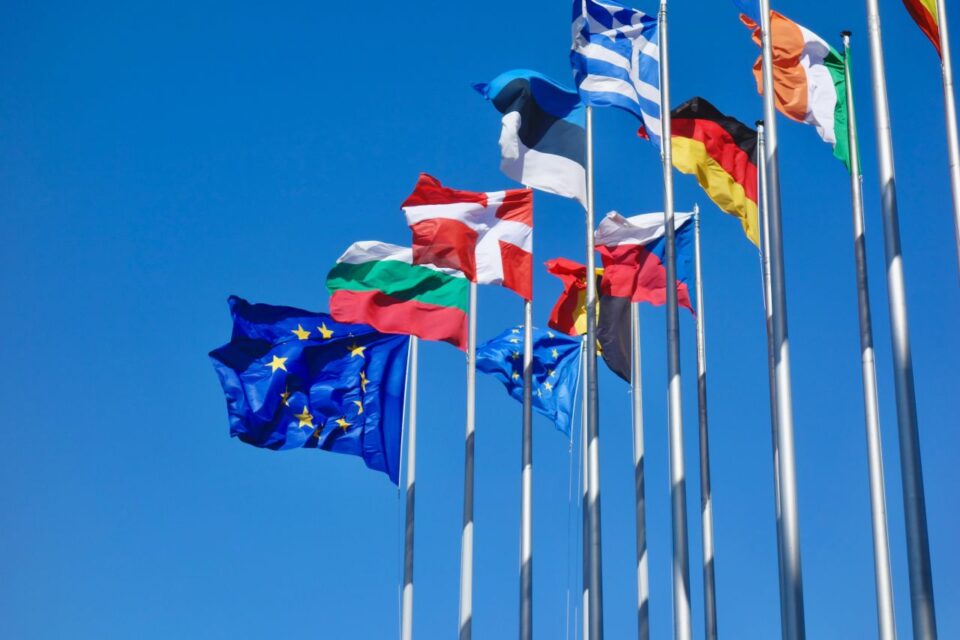Happy Easter in Different Languages & Easter Traditions
Can the Easter bunny say “Happy Easter” in all these languages? 🐰 Let’s find out.
Over 45% of the world’s population speaks an Indo-European language as a first language. 💡

As Europe Day draws near, it’s the perfect occasion to explore the incredible linguistic diversity Europe has to offer. Home to a plethora of languages, many of which belong to the vast Indo-European language family, Europe boasts a rich linguistic landscape that plays a crucial role in shaping its cultural identity. To understand how multilingualism promotes unity and cooperation on the continent, let’s explore the endlessly fascinating languages of Europe.
Join us for Europe Day (and beyond) in this fantastic quest through the Indo-European languages. During this linguistic quest, we will make several stops:
According to the European Union, Europe Day celebrates peace and unity in Europe. May 9th marks the anniversary of the historic ‘Schuman Declaration’, an ambitious plan that suggested a new way for European countries to work together, making war between them impossible. Schuman’s proposal is widely regarded as the genesis of the present-day European Union.
Europe Day also serves as a reminder of the importance of unity, cultural diversity, and the shared values that bind the European community together.
In 1950, European countries were recovering from World War II, which ended five years earlier. To prevent another devastating war, European governments decided to combine their coal and steel production. This would make war between France and Germany practically impossible, and it was believed that joining economic interests would improve living standards and create a more united Europe.
The Schuman Declaration, presented by French Foreign Minister Robert Schuman on May 9, 1950, proposed the creation of the European Coal and Steel Community (ECSC). The ECSC, with founding members France, West Germany, Italy, the Netherlands, Belgium, and Luxembourg, was the first in a series of European institutions that eventually evolved into today’s European Union.
Europe is home to several major language families, the most prominent being the Indo-European language family. Other significant language families include Uralic, Turkic, and Basque, each contributing to the rich linguistic landscape of the continent.
Comprising over 400 languages spoken by over 45% of the world’s population, it is believed that Indo-European languages originated from a hypothetical language called Proto-Indo-European, which is no longer in use.
It seems that the earliest speakers of Proto-Indo-European originally lived around today’s Ukraine and the nearby regions in the Caucasus and Southern Russia. What allowed the language to spread so far and wide was, interestingly enough, the people’s success in domesticating cattle, dogs, and, above all, horses. This allowed them to distribute the language across Eurasia on their horses.

Because Proto-Indo-European speakers didn’t create a writing system, we don’t have any written records of their language. Linguists have tried to recreate this ancient language using different methods. Even though a perfect reconstruction may not be possible, we still have a general idea of the language and culture these early speakers shared.
Today, Indo-European languages are widely spoken in the Americas, Europe and Western and Southern Asia.
The Indo-European language family is, in turn, divided into several branches, each consisting of a group of related languages. Here are some of the major Indo-European branches:
All these branches reflect the vast geographic spread and historical development of the Indo-European languages. Who would have guessed Romance languages and Indic languages come from the same European language family? The linguistic diversity found within this influential language family is incredible, to say the least.
Are there any Non-Indo-European languages in Europe? Yes, Turkish and Finnish are the most prominent of them. However, this is not the complete list.
As you saw in the previous paragraphs, Indo-European languages extend far beyond Europe. But the reverse is also true. The most notable Non-Indo-European languages in Europe today are:
As you can see, there aren’t many Non-Indo-European languages in Europe. The vast majority is represented by the aforementioned Indo-European languages, which are equally intricate and diverse.
With an abundance of languages in Europe, determining the best one to learn can be a challenge. Sure, Europeans are known for their good command of English, but what’s the next best language to learn? If you want to travel or even work in Europe, surely the most practical to learn is the most spoken. To help you decide, let’s look at the top five most spoken languages in Europe. By number of native speakers, of course.
Given its wide territory, Russian is the most spoken native language in Europe. With more or less 130 million native speakers on the European continent, Russian is the official language of Russia and Belarus. Additionally, many older people in Eastern Europe speak Russian because it was taught in schools during the Soviet Era.
Many people avoid learning Russian because of the Cyrillic alphabet. However, that shouldn’t stop you too. The Russian alphabet is actually easy to master once you get the hang of it!
With roughly 95 million native speakers in Germany, Austria, Switzerland, Belgium, Luxembourg and Lichtenstein, German sits in the second spot on our list. While many people consider German hard to learn, they are not quite right. It may be a tad more difficult, but not the hardest and certainly not impossible. According to the FSI (Foreign Service Institute) of the US government, an English speaker would need about 750 class hours or 30 weeks of practice to become fluent in German.
Along with English, French is the only language spoken on five continents. Still, its influence in Europe remains just as strong, with no less than 67 million native speakers.

If you think about learning French, don’t forget to consider the long list of French-speaking countries. Speaking French won’t only give an advantage in Europe but also worldwide.
You saw this coming, right? English is the most spoken language worldwide by total number of speakers. But in Europe, it only has approximately 65 million native speakers who reside in the United Kingdom and the Republic of Ireland.
Nowadays, English is the lingua franca of the world. Europeans are famous for their good command of English. However, if you’re reading this article, you probably already know English and you should look at the next language on this list.
The language of painters and pasta, Italian comes in fifth for the largest native-speaking population in Europe. Roughly 60 million native speakers use their 250 hand gestures to speak Italian with such passion.
Apart from Italy, you’ll also find Italian speakers in Switzerland and the Vatican City.
Honorable mentions: Spanish, Ukrainian, Polish, Romanian and Dutch.
Learning a new language can be challenging, and some European languages are considered particularly hard to learn due to their complex grammar, vocabulary or pronunciation.
However, a language’s level of complexity is not given at random. You may feel like a European language is hard to learn, but classification has to be made by experts. The Foreign Service Institute of the US Government in this case. What recommends them? The FSI has some 800 language learning courses in 70 languages with over 70 years of experience in instructing US diplomats and foreign affairs employees to learn languages.
According to them, the hardest European languages to learn are:
The FSI classifies all these European languages as tier 4 out of 5 – with 5 being the highest difficulty level. A native English speaker would need 1100 hours or 44 weeks of study to achieve fluency in one of these European languages.
Surprisingly, German didn’t make this list as it is easier to learn than all these languages. Being at tier 2, German only requires 750 hours or 30 weeks of study for fluency.
Whether we’re talking about Indo-European languages or not, here are all the languages of Europe and where they are spoken:
| Language | Countries where spoken |
|---|---|
| Albanian | Albania, Kosovo, North Macedonia |
| Basque | Spain, France |
| Belarusian | Belarus |
| Bosnian | Bosnia and Herzegovina |
| Breton | France |
| Bulgarian | Bulgaria |
| Catalan | Spain, Andorra |
| Croatian | Croatia, Bosnia and Herzegovina |
| Czech | Czech Republic |
| Danish | Denmark |
| Dutch | Netherlands, Belgium, Suriname |
| English | United Kingdom, Ireland, Malta, Gibraltar, Cyprus |
| Estonian | Estonia |
| Finnish | Finland |
| French | France, Belgium, Switzerland, Canada, Luxembourg, Monaco |
| Galician | Spain |
| German | Germany, Austria, Switzerland, Belgium, Luxembourg, Liechtenstein |
| Greek | Greece, Cyprus |
| Hungarian | Hungary |
| Icelandic | Iceland |
| Irish | Ireland |
| Italian | Italy, Switzerland, San Marino, Vatican City |
| Latvian | Latvia |
| Lithuanian | Lithuania |
| Macedonian | North Macedonia |
| Maltese | Malta |
| Norwegian | Norway |
| Polish | Poland |
| Portuguese | Portugal, Brazil, Angola, Mozambique, Cape Verde |
| Romanian | Romania, Moldova |
| Russian | Russia, Belarus, Kazakhstan, Kyrgyzstan |
| Serbian | Serbia, Bosnia and Herzegovina, Montenegro |
| Slovak | Slovakia |
| Slovenian | Slovenia |
| Spanish | Spain, Mexico, Colombia, Argentina, Peru, Venezuela, Chile |
| Swedish | Sweden |
| Turkish | Turkey |
| Ukrainian | Ukraine |
How do we celebrate Europe Day? Well, if you learned something new about the languages of Europe by reading this article, you already started the celebrations. By honoring and learning about the languages of Europe, we can appreciate the continent’s vibrant cultural tapestry and strengthen the bonds that unite us all.

If you want to go the extra mile, you can organize or participate in language exchange events or cultural activities. Many institutions organize dedicated events to commemorate this special day for Europe.
The most prominent of them are those organized by the European Union. Make sure you check their list of events and activities for this year and join if you can! Europe Day and multilingualism promote cross-cultural understanding, foster economic collaboration, and enhance personal development. Taking part in such celebrations can only benefit you.
Do you want to learn some of Europe’s languages? Try Mondly, the award-winning language app that is serious about making language learning fun.
Instead of tiring yourself for hours with inch-thick textbooks, slip a 10-minute Mondly lesson into your routine and make learning a breeze. You will learn languages naturally using:
Start using Mondly for free on your computer or download the app and learn the languages of Europe anytime, anywhere.

Can the Easter bunny say “Happy Easter” in all these languages? 🐰 Let’s find out.

Language learning myths prevent people from even trying to learn a new language. Here are the most common myths about language learning.

Teachers are the best people in the world. They always go above and beyond to support their students. Let's wish them all "Happy teachers' Day!"